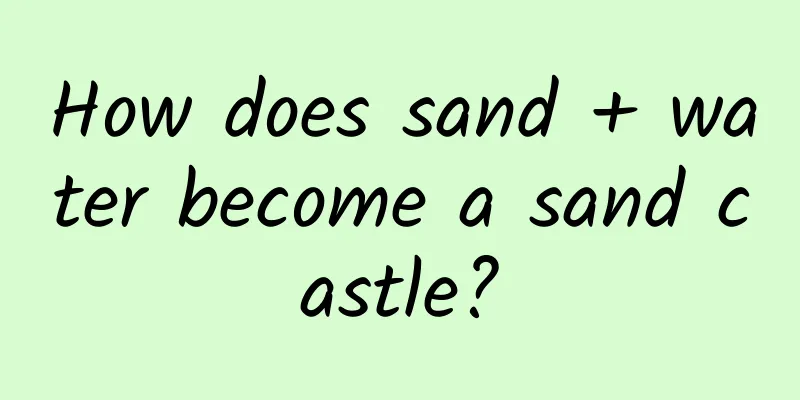How does sand + water become a sand castle?

|
When you are at the beach, you can always see sand sculptures of all sizes. Don't get me wrong, they are fortresses made of sand. The entry-level ones are just small hills, while the more advanced ones are varied, with animals, human figures, and cartoons. The shapes of sand sculptures are ever-changing, as if every grain of sand has a soul. Image source: Photo Network When building a sand sculpture, you need to mix sand and water. It is generally believed that 8 buckets of sand to 1 bucket of water is a more appropriate ratio. After adding water, the sand, which was originally very loose and distinct in grains, can be bonded together to form a solid mass. At this time, you can shape large pieces of sand into various shapes like kneading plasticine, and assemble them into sand sculptures like building blocks. So why can simply adding some water make the sand grains bond together? 01The magic of water and sand mixing If we zoom in on a pile of wet sand, we will find that there is a small section of water column between the sand grains, and the side surface of this part of the water column will be concave inward. In the tangent direction of the concave liquid surface, the water column can produce a pulling force on the sand grains on both sides, making the sand grains on both sides close to each other and produce the effect of sticking together. The liquid bridges between the sand particles can provide adhesion, which is essentially the surface tension of the liquid. Image source: @Institute of Physics, Chinese Academy of Sciences These phenomena all have scientific names. The column of water between the sand grains is called a liquid bridge . The pull on the concave liquid surface is called the surface tension of the liquid. The adhesion, closeness and even relative movement caused by surface tension are called capillary phenomena. It can be seen that the surface tension of water is the essential reason for the adhesion of sand particles. So how does it appear? This needs to be explained from a more microscopic perspective. A drop of water contains a large number of water molecules. There are also certain interactions between molecules, which are called intermolecular forces , or van der Waals forces . When the distance between two molecules is too close, there is a repulsive force between the two; and when the distance between two molecules is too far, there is an attractive force between the two. The relationship between the intermolecular force and the distance between molecules. Source: hand-drawn by the author Inside a water droplet, each water molecule interacts with other water molecules in all directions. Due to the characteristics of intermolecular forces, these water molecules will automatically adjust the distance between each other so that each molecule is balanced by the combined force of other molecules in all directions. This is equivalent to attraction equals repulsion. However, in the thin layer adjacent to the surface of the water droplet and the air, the situation is different. Unlike the interior of a water droplet, water molecules on the surface only interact with other water molecules in the cross-section of the water droplet and in the inward direction, which destroys the symmetry of space and force. After the distance is automatically adjusted, the distribution of water molecules on the surface will be sparser than that inside the water droplet , and the distance between molecules will be increased, thus reflecting the overall attraction on the surface of the water droplet. This is the source of surface tension. A diagram that is not very accurate in theory but relatively easy to understand is used to help understand the formation of surface tension. The dotted line represents the distribution of molecules on the liquid surface, and the solid line represents the distribution of molecules inside the liquid surface. It can be seen that the distance between molecules on the surface is larger, thus reflecting the mutual attraction on the surface. Image source: hand-drawn by the author Surface tension makes the surface of a water droplet equivalent to a stretched "film" . For the liquid bridge between sand grains, this stretched "film" on the liquid surface will transmit a pulling force to the sand grains connected on both sides to promote their close proximity. However, surface tension is a relatively weak force. If the size of the liquid bridge is too large, the surface tension will not be able to resist the gravity of the liquid itself, and the liquid bridge will collapse, and the sand grains will lose their bonding connection. Therefore, in order to build a solid sand sculpture, it is not the case that adding more water is better. Studies have shown that the more water there is in the sand, the larger the liquid bridge is, which can further enhance the bonding effect. However, as the liquid bridge grows larger, the bonding force decreases accordingly. Within a certain range of water content, the force that binds the sand together is independent of the water content. But in space, due to the microgravity environment, the size of the liquid bridge can become very large. In our Tiangong classroom, astronaut Wang Yaping gave us a vivid demonstration. On the International Space Station, a liquid bridge with a diameter of 50 mm has also been built. Liquid bridges on Earth are at most a few millimeters, while liquid bridges in space can be very large. Image source: Tiangong Classroom In addition to helping sand grains to bond, the role of surface tension can also be seen in many life scenes. When a cup of water is full, its liquid level can be a certain distance above the mouth of the cup without spilling. This is because the surface tension restrains the movement of the internal liquid, which is equivalent to a layer of elastic film holding the water. Insects such as water striders can walk freely on the water surface because surface tension gives the liquid surface a certain supporting capacity. Plants can spontaneously absorb water and nutrients from the ground, and they also rely on surface tension to overcome the liquid's own gravity, thereby completing the transportation from bottom to top. The role of surface tension is everywhere in life. Source: sohu 02What is space sand that can gather and disperse? Now, you should understand why water can act as an adhesive in sand sculptures. But some friends may have new questions: There is a kind of space sand that can be molded into various shapes without adding water. What is the principle? Space sand is actually ordinary sand that has been specially treated, that is, it is covered with silicone (commonly known as "silicone oil"). This is an organic silicon oxide polymer composed of silicon and oxygen, and its structure is composed of a series of repeated units linked into long chain molecules. Silicone has a wide range of applications in many fields, from daily consumer products such as cosmetics, lotions, shampoos and conditioners to lubricants and sealants in the industrial field. Silicone exhibits unique physical properties. It can exist as a free-flowing liquid or a slow-flowing semi-solid when no external forces are applied, but once it is stressed it becomes a solid, rubber-like state. This property of adjusting its physical state in response to applied loads is called viscoelasticity. The degree of viscoelasticity is closely related to the length of the polymer chains in the silicone. Space sand, a viscoelastic material, can exhibit the viscosity of a fluid or the elasticity of a solid under different load conditions. Image credit: @科林 Silicon material In space sand, the polymer chains of silicone act like adhesives to tightly connect the sand particles, allowing the sand to be kneaded arbitrarily, just like plasticine, and molded into various shapes. However, once the external force is removed, over time, due to the influence of the material's viscoelasticity, the space sand will slowly flow like a fluid, causing the molded shape to gradually flatten and eventually collapse. Whether it is ordinary sand plus water or novel space sand, the process of shaping sand sculptures can bring us joy. How long have you not played with sand? After reading this article, make a sand sculpture yourself! Author: Wei Anran, Application Engineer, PhD in Mechanics, Shanghai Jiao Tong University Planning & Editing: Tiara Cover image source: Photo Network |
<<: Weighing more than two pigs! How was this champion giant pumpkin grown?
Recommend
The new version of App Store may have a severe blow to the ranking business, but there is still hope
On September 20, Apple officially pushed the iOS ...
Insights and solutions for the automotive industry during the epidemic
At the beginning of the Year of the Rat, a sudden...
Electric Technology Car News: Changan Lingxuan vs. Volkswagen Touran L: The configuration is equivalent and the price is only half
Speaking of Volkswagen's Touran, it is a very...
Avoid 40 pitfalls in fission activities!
The advent of the community economy has made know...
Why are there always so many small animals around capybaras?
If life is a game, then friends are the most spec...
Whoever has the traffic will win the world?
Discussions about traffic have always been a hot ...
3 data analysis methods that product operators must know!
“What kind of product operation is it?” “Is produ...
The new platform enables Great Wall Motors to sell 618,211 vehicles from January to June, a year-on-year increase of 56.5%!
On July 8, Great Wall Motor Co., Ltd. (stock code...
K12 Online Education: Yuanfudao Product Analysis
This article aims to help you understand the curr...
Lily SEO Training: What are the aspects of search engine friendliness?
First: Directory Structure A clear and concise di...
Short video + live broadcast to make money, teach you how to easily make an extra 20,000 per month
Course Outline In 2020, ordinary people cannot mi...
Talking Sheep: Have you ever heard of a lawn mower that doesn't need to be charged?
I am Dong Dong Meow Talking animals are so fun! T...
3 tips to make event operations more efficient!
Today, let’s talk about event operations . The so...
Just observe the bubbles, this article will teach you how to become a wine connoisseur
Author: Deuterium The article comes from the Scie...
Apple officially abandons iTunes! How to sync iPhone and iPad to Mac?
Recently, Apple officially released the new syste...









